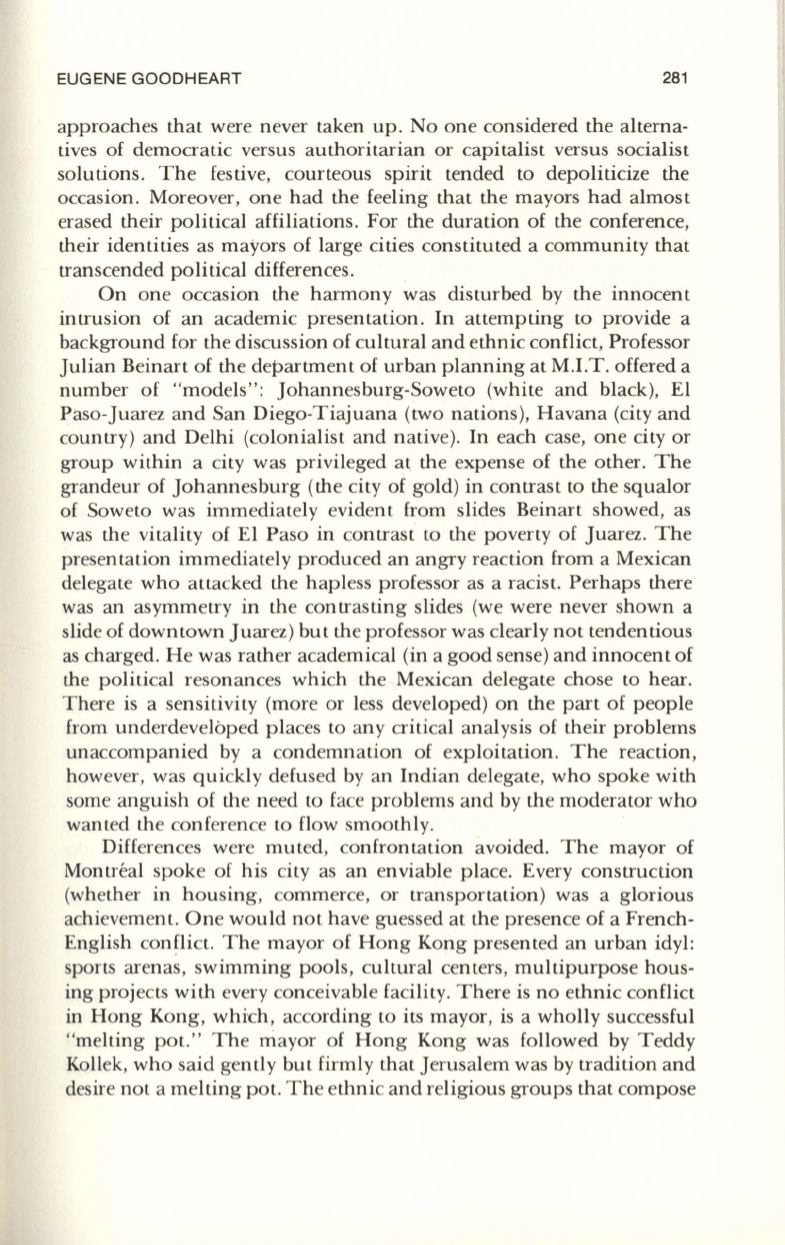
EUGENE GOODHEART
281
approaches that were never taken up. No one considered the alterna–
tives of democratic versus authoritarian or capitalist versus socialist
solutions. The festive, courteous spirit tended
to
depoliticize the
occasion. Moreover, one had the feeling that the mayors had almost
erased their political affiliations. For the duration of the conference,
their identities as mayors of large cities constituted a community that
transcended political differences.
On one occasion the harmony was disturbed by the innocent
intrusion of an academic presentation. In attempting to provide a
background for the discussion of cultural and ethnic conflict, Professor
Julian Beinart of the department of urban planning at M.LT. offered a
number of "models": Johannesburg-Soweto (white and black), EI
Paso-Juarez and San Diego-Tiajuana (two nations), Havana (city and
country) and Delhi (colonialist and native). In each case, one city or
group within a city was privileged at the expense of the other. The
grandeur of Johannesburg (the city of gold) in contrast to the squalor
of Soweto was immediately evident from slides Beinart showed, as
was the vitality of EI Paso in contrast to the poverty of Juarez. The
presentation immediately produced an angry reaction from a Mexican
delegate who attacked the hapless professor as a racist. Perhaps there
was an asymmetry in the contrasting slides (we were never shown a
slide of downtown Juarez) but the professor was clearly not tendentious
as charged. He was rather academical (in a good sense) and innocent of
the political resonances which the Mexican delegate chose to hear.
There is a sensitivity (more or less developed) on the part of people
from underdeveloped places to any critical analysis of their problems
unaccompanied by a condemnation of exploitation. The reaction,
however, was quickly defused by an Indian delegate, who spoke with
some anguish of the need to face problems and by the moderator who
wanted the conference
to
flow smoothly.
Differences were muted, confrontation avoided. The mayor of
Montreal spoke of his city as an enviable place. Every construction
(whether in housing, commerce, or transportation) was a glorious
achievement. One would not have guessed at the presence of a French–
English conflict. The mayor of Hong Kong presented an urban idyl:
sports arenas, swimming pools, cultural centers, multipurpose hous–
ing projects with every conceivable facility. There is no ethnic conflict
in Hong Kong, which, according to its mayor, is a wholly successful
"melting pot." The mayor of Hong Kong was followed by Teddy
Kollek, who said gently but firmly that Jerusalem was by tradition and
desire not a melting pot. The ethnic and religious groups that compose


